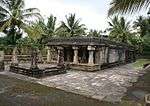Jainism in Kerala
| Part of a series on |
| Jainism |
|---|
 |
|
Jain prayers |
|
Ethics |
|
Major figures |
|
Major sects |
|
Festivals |
|
Pilgrimages |
|
|
Jainism has had a continued presence in Kerala since pre-Christian times.[1] At present, Jainism in Kerala has a small following, mainly descendant of the original Jains of Kerala, and the migrant Jain business community.
Origin of Jainism in Kerala
Jainism came to Kerala in the third century BC soon after Chandragupta Maurya (B.C. 321-297), accompanied by the Jain monk Bhadrabahu, travelled to Shravanabelagola near Mysore (in present day Karnataka). Their followers are believed to have journeyed further south, into present day Kerala and Tamil Nadu, in search of suitable places for meditation. By the start of the Christian era, Jainism was well established in Kerala. Ilango Adigal, author of the Tamil epic Silappatikaram, was among the notable royal patrons of the Jain religion in Kerala. He lived in Trikkanaa-Mathilakam which attained fame as a centre of Jain culture and learning.
Jainism started its decline in Kerala during the 8th century resurgence of the Saivite and Vaishnavite movements, and by the 16th century it had almost disappeared. Some Jain shrines from these times still remain, notably in Jainamedu, near Vadakkanthara, Palghat, and in Sultan Battery in Wynad. Many Jain temples were also demolished during Tipu Sultan's raid.
There were many Jain temples spread over Kerala in ancient times. Koodalmanikyam Temple in Irinjalakuda is believed to have been among them. The belief is that it was dedicated to Bharatheswara, a Digambar Jain monk (his statue can be seen in Shravanabelagola). Jainism declined in popularity in Kerala during the Saivite and Vaishnavite resurgence, and many Jain shrines, among them Koodalmanikkyam, became Hindu temples.[2][3][4][5]
The temple at Kallil, in Perumbavoor, was believed to have been a Jain shrine to Parshvanatha, Mahavira, and Padmavathi Devi. Now it is a Hindu shrine dedicated to Devi, but Jain pilgrims also pray there.[6][7]
The temple architecture of Kerala owes much to the architecture of Jain temples.[8] Some famous Jain temples located in Kerala are:
- Anantnath Swami Temple (also known as the Puliyarmala Jain Temple) in Puliyarmala, outside of Kalpetta in Wayanad district, Kerala.
- Sultan Bathery Jain Temple, Wayanad
- Jainimedu Jain temple
- Jain temple, Alleppey
- Kallil Temple in Perumbavoor, Ernakulam
- Kattil Madam Temple
- Dharmanath Jains Temple, Mattancherry, Kochi
- Chathurmukha Basati in Manjeshwar
- Parswanatha Basati, Manjeshwar
- Shri Vasupujya Swami Jain Temple, Srinivasa Mallan Road, Ernakulam
- Cochin Digambar Jain Mandir - Panampilly Nagar, Kochi 682036, Kerala.
Photo gallery
 Anantnath Swami Temple more than 2100 years old
Anantnath Swami Temple more than 2100 years old Jain temple in Mattancherry, Kochi
Jain temple in Mattancherry, Kochi- Jain art & carvings at Chitharal Jain Temple
 Jain art & carvings at Chitharal Jain Temple
Jain art & carvings at Chitharal Jain Temple
 Chandranath Swami Basadi in Wayanad
Chandranath Swami Basadi in Wayanad Jain temple in Sultan Bathery
Jain temple in Sultan Bathery- Jain temple in Manjeshwar, Kasargod district

 Shri Vasupujya Swami Jain Temple
Shri Vasupujya Swami Jain Temple
See also
References
- ↑ The Spirituality of Basic Ecclesial Communities in the Socio-Religious ... - Selvister Ponnumuthan.
- ↑ Cultural heritage of Kerala: an introduction - A. Sreedhara Menon. 1980-01-01. Retrieved 2012-06-02.
- ↑ "Chathurmukha basti, Jain temple, Kasaragod, Video, India". Keralatourism.org. Retrieved 2012-06-02.
- ↑ "Irinjalakkuda Koodalmanikya Swami Temple". Vaikhari.org. Retrieved 2012-06-02.
- ↑ "Introduction to Temples of Kerala". Thrikodithanam.org. 2001-05-10. Retrieved 2012-06-02.
- ↑ "IT Kerala". Manoramaonline.com. 2008-11-14. Retrieved 2012-06-02.
- ↑ Sajnani, Manohar. Encyclopaedia of Tourism Resources in India.
- ↑ "Jain Temples in Sultan Bathery, Digambar sect, Wayanad, District, Kerala, India - Kerala Tourism".
External links
| Wikimedia Commons has media related to Jainism in Kerala. |
|
| |
|
|